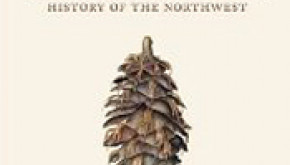
Jack Nisbet's The Collector: David Douglas and the Natural History of the Northwest (Sasquatch Books, 2009).
Reviewed by Renee D'Aoust.
In 1824, London’s Royal Horticultural Society sent the young botanist David Douglas on an expedition to the Pacific Northwest to study and to collect native flora and fauna. The previous year Douglas had traveled from Britain to the East Coast of America where his natural curiosity and physical vigor allowed him the constant pursuit of plants requested by the Royal Society. That trip animated Douglas’s desire to explore the Pacific Northwest.
The sensitive details of Douglas's journey are marvelously captured by the contemporary author and naturalist Jack Nisbet in The Collector: David Douglas and the Natural History of the Northwest (Sasquatch Books, 2009).While many readers will be familiar with Nisbet’s work, many of those same readers will not realize the extent to which David Douglas traversed the Pacific Northwest, naming our most common plants.
Readers may also not know, before reading Nisbet’s account, the extent to which Douglas took so many plants back to England and propagated them into English gardens. Of the East Coast trek, Nisbet writes: “The four Washington plums that Douglas carefully suspended in a jar of alcohol epitomized the purpose of his journey: to capture some of the New World’s unpredictable vigor and infuse it back into the Old.”
While some explorers plundered Greek ruins and brought them to the British museum, many conifers and other shrubs and plants Douglas collected transformed the British landscape. And today, unlike Greece and Britain, which have been involved in intense negotiations about sculptures taken from the Parthenon, the United States and Britain are not involved in negotiations about plants. Still, this reader wondered about the imperialistic overtones of Douglas’s travels; for example, was it really necessary for Douglas to blow that many albatross birds out of the marine sky?
Nevertheless, Nisbet’s account focuses so intensely on Douglas that it gives readers an uncanny insider’s view of his compelling travels. It is fitting that issues of imperial collecting and plunder should rightly be left to other historians and other books. Besides, the author Nisbet is attuned to the time and place Douglas explores in the Pacific Northwest; Nisbet writes:
In Douglas’s time, some of the most prominent of the rock faces between the Dalles and Celilo showed carefully pecked patterns of petroglyphs and the streaked red slashes of pictographic art. Their styles reflected the astonishing mix of cultures that made their way to the rapids during the salmon runs to participate in the Columbia’s largest trade market. Douglas saw the plants and the people and the fish, but made no mention of any stone faces staring at him while he worked.
As shown in his previous books, such as Sources of the River: Tracking David Thompson across Western North America, Nisbet has that rare ability to integrate many facets of a story into one compelling narrative. Nisbet’s The Collector: David Douglas and the Natural History of the Northwest reads like a new form of naturalist book—a botanical page turner; for example, Nisbet writes: “[Douglas] identified lodgepole and ponderosa pines as well as Engelmann spruce, but was most impressed by the western tamaracks, measuring several up to thirty feet in circumference and pacing off one fallen tree at 144 feet to the first branch, straight and clear.” Picture such a tamarack!
The Collector: David Douglas and the Natural History of the Northwest makes for a thrilling read precisely because Nisbet makes it possible for a reader to feel he or she is right there with Douglas. Nisbet suggests that several stories about Douglas are the stuff of legend, and he provides valuable details to separate mythological chaff from compelling history. Besides, in Nisbet’s skill hands, Douglas’s real story is more than enough.
Although unfailingly enthusiastic, at times Douglas struggles with competition and worry, particularly when he learns that “a specimen box had been injured during the journey…. [Douglas] fretted when he learned the post factor had asked naturalist Thomas Drummond to open the box and change some of the papers. ‘This was kind,’ the protective Douglas wrote, while admitting that he did ‘not relish a botanist coming in contact with another’s gleanings.’” But Drummond causes no harm to Douglas’s collection.
Nisbet excels at this kind of integrated writing that combines historical knowledge with entries directly from Douglas’s own journals. Nisbet’s botanical knowledge is used to describe plants while his keen historical sense conveys Douglas’s state of mind. Because of Nisbet’s multiple and combined skills, Nisbet creates a complete and nuanced world full of details that propel Douglas’s story forward to its fatal end.
The Collector: David Douglas and the Natural History of the Northwest would be a perfect companion for a modern family’s summer road trip.
For information about The Collector: David Douglas and the Natural History of the Northwest and more information about author, naturalist, and teacher Jack Nisbet, please visit Nisbet’s web-site.
[A full version of this book review first appeared in the Idaho Forest Owners Newsletter.]

